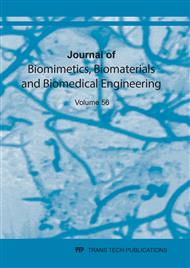[1]
M. Fanuscu, V. Hung, and P. Bernard, Implant biomechanics in grafted sinus: a finite element analysis., Journal of Oral Implantology, 30. 2, (2004) 59-68.
DOI: 10.1563/0.674.1
Google Scholar
[2]
B. Mohammadi, Z. Abdoli, and E. Anbarzadeh, Investigation of the Effect of Abutment Angle Tolerance on the Stress Created in the Fixture and Screw in Dental Implants Using Finite Element Analysis,. In Journal of Biomimetics, Biomaterials and Biomedical Engineering, Vol. 51, (2021) 63-76.
DOI: 10.4028/www.scientific.net/jbbbe.51.63
Google Scholar
[3]
A. Bacchi, et al, Effect of framework material and vertical misfit on stress distribution in implant-supported partial prosthesis under load application: 3-D finite element analysis,. Acta Odontologica Scandinavica. 1;71(5), (2013) 1243-1249.
DOI: 10.3109/00016357.2012.757644
Google Scholar
[4]
A. A. Mamalis, S. S. Silvestros, Analysis of osteoblastic gene expression in the early human mesenchymal cell response to a chemically modified implant surface: an in vitro study,, Clinical oral implants research, 22(5), (2011) 530-537.
DOI: 10.1111/j.1600-0501.2010.02049.x
Google Scholar
[5]
A. Kasim, et al, Development of porous Ti-6Al-4V dental implant by metal injection molding with palm stearin binder system., In Materials Science Forum, Trans Tech Publications Ltd. vol. 889, (2017) 79-83.
DOI: 10.4028/www.scientific.net/msf.889.79
Google Scholar
[6]
A. Yodrux, Y. Nantakrit, and J. Manutchanok, Three-Dimensional Finite Element Analysis of Dental Implant Threads., In Applied Mechanics and Materials, vol. 876, (2018) 138-146.
DOI: 10.4028/www.scientific.net/amm.876.138
Google Scholar
[7]
K. T. Koo, et al, Implant surface decontamination by surgical treatment of periimplantitis: a literature review,, Implant dentistry, 28(2), (2019) 173-176.
DOI: 10.1097/id.0000000000000840
Google Scholar
[8]
S.M. Croitoru, I. Marinela, Study on Shape of Dental Implants., In Advanced Engineering Forum, vol. 34, (2019) 183-188.
DOI: 10.4028/www.scientific.net/aef.34.183
Google Scholar
[9]
A. N. Natali, E. L. Carniel, and P.G. Pavan, Modelling of mandible bone properties in the numerical analysis of oral implant biomechanics,, Computer methods and programs in biomedicine, 1;100(2), (2010) 158-165.
DOI: 10.1016/j.cmpb.2010.03.006
Google Scholar
[10]
M.D. Fabbro, et al, Tilted implants for the rehabilitation of edentulous jaws: a systematic review,, Clinical implant dentistry and related research, 14(4), (2012) 612-621.
DOI: 10.1111/j.1708-8208.2010.00288.x
Google Scholar
[11]
T. H. Lan, et al, Biomechanical analysis of alveolar bone stress around implants with different thread designs and pitches in the mandibular molar area,, Clinical oral investigations, 1;16(2), (2012) 363-369.
DOI: 10.1007/s00784-011-0517-z
Google Scholar
[12]
J. C. Chen, et al, In vivo studies of titanium implant surface treatment by sandblasted, acid-etched and further anchored with ceramic of tetra calcium phosphate on osseointegration,, Journal of the Australian Ceramic Society, 55(3), (2019) 799-806.
DOI: 10.1007/s41779-018-00292-5
Google Scholar
[13]
G. Le, et al, Osteoblastic cell behaviour on different titanium implant surfaces,, Acta Biomaterialia. 4(3), (2008) 535-543.
DOI: 10.1016/j.actbio.2007.12.002
Google Scholar
[14]
G. Strnad, C. Nicola, and J. F. Laszlo, Effect of surface preparation and passivation treatment on surface topography of Ti6Al4V for dental implants,, In Applied Mechanics and Materials, vol. 809, (2015) 513-518.
DOI: 10.4028/www.scientific.net/amm.809-810.513
Google Scholar
[15]
M. Stimmelmayr, et al, Wear at the titanium–titanium and the titanium–zirconia implant–abutment interface: a comparative in vitro study,, Dental Materials. 28(12), (2012) 1215-1220.
DOI: 10.1016/j.dental.2012.08.008
Google Scholar
[16]
Q. Wang, et al, Multi-scale surface treatments of titanium implants for rapid osseointegration: a review,. Nanomaterials, 10(6), (2020) 1244-1274.
DOI: 10.3390/nano10061244
Google Scholar
[17]
M.A. Alfarsi, S.M. Hamlet, and S. Ivanovski, Titanium surface hydrophilicity enhances platelet activation,, Dental materials journal. 28, (2014) 2013-2021.
DOI: 10.4012/dmj.2013-221
Google Scholar
[18]
E.S. Kim, S.Y. Shin, Influence of the implant abutment types and the dynamic loading on initial screw loosening,, The journal of advanced prosthodontics, 5(1), (2013) 21-28.
DOI: 10.4047/jap.2013.5.1.21
Google Scholar
[19]
C. Morrison, et al, In vitro biocompatibility testing of polymers for orthopaedic implants using cultured fibroblasts and osteoblasts,. Biomaterials, 16(13), (1995) 987-992.
DOI: 10.1016/0142-9612(95)94906-2
Google Scholar
[20]
E. Conserva, M. Menini, G. Ravera, and P. Pera, The role of surface implant treatments on the biological behavior of SaOS‐2 osteoblast‐like cells,. An in vitro comparative study. Clinical oral implants research, 24(8), (2013) 880-889.
DOI: 10.1111/j.1600-0501.2011.02397.x
Google Scholar


